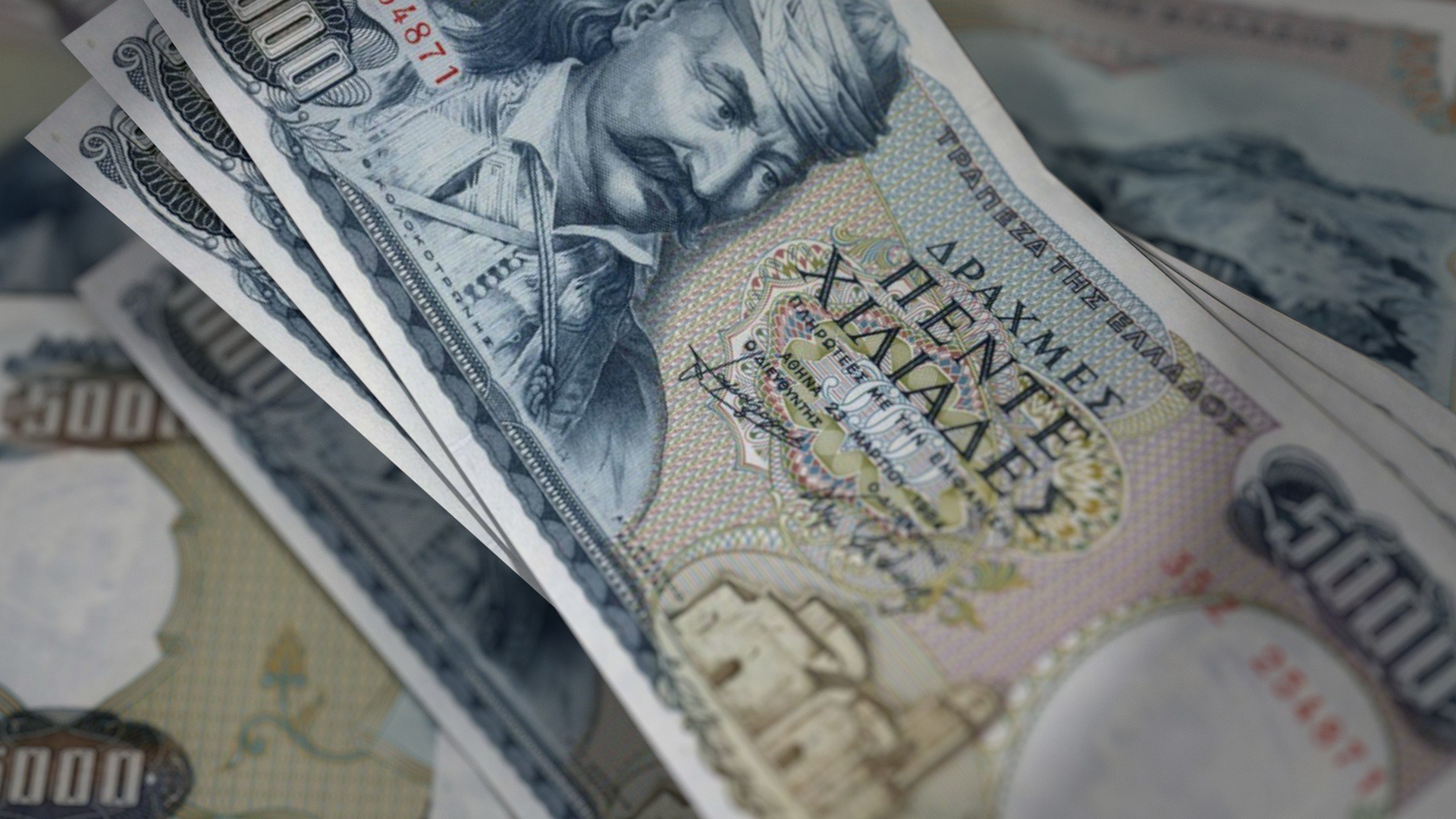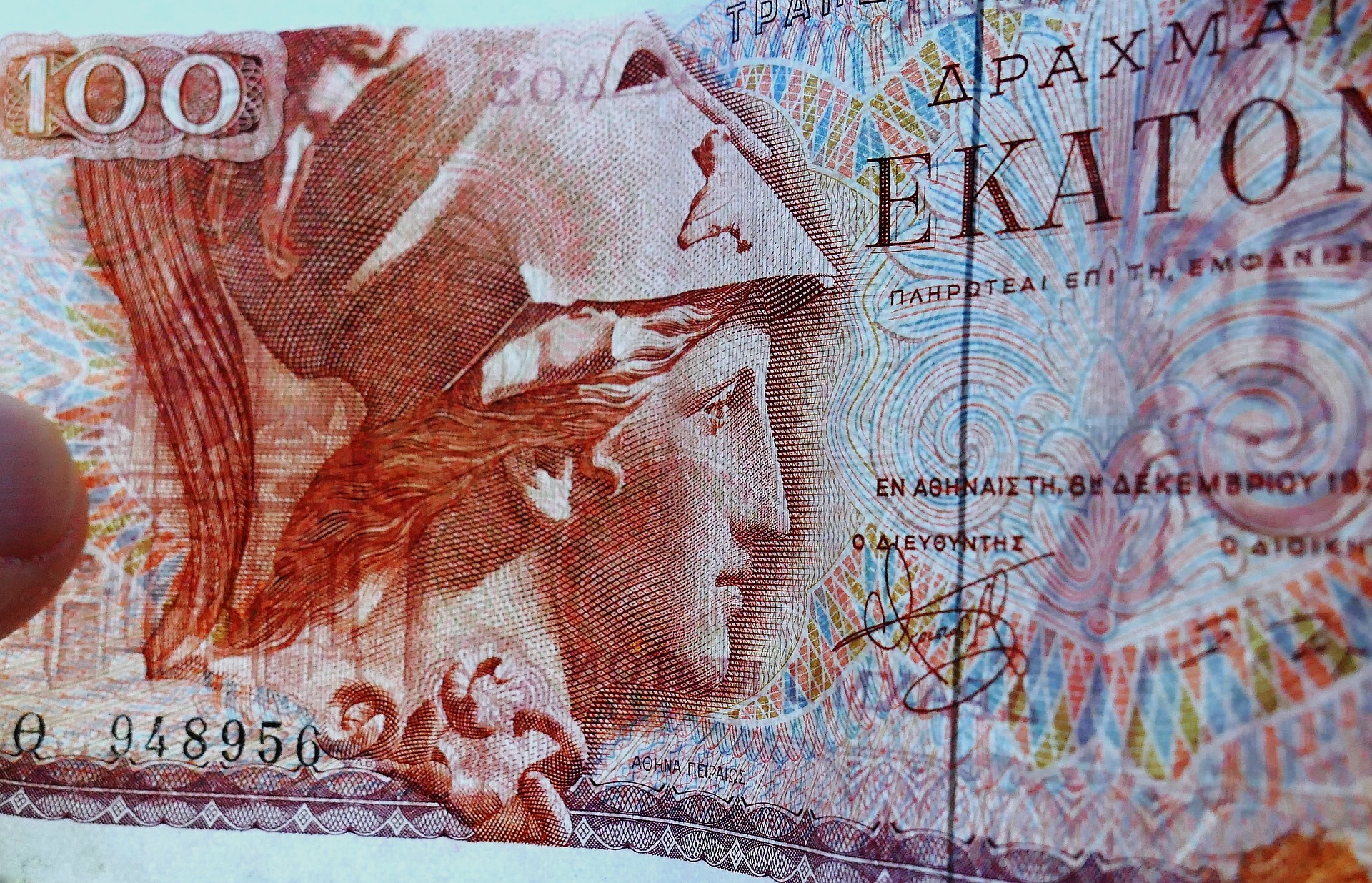Griechenland, das Land der Götter und Mythen, hat nicht nur eine reiche kulturelle Geschichte, sondern auch eine faszinierende monetäre Vergangenheit und Gegenwart. Von der Einführung der Drachme in der Antike bis zum Beitritt zur Eurozone – die Geschichte des griechischen Geldes ist ein Spiegelbild der politischen und wirtschaftlichen Entwicklungen des Landes.
Von HB-Redakteurin Soula Dimitriou
- From Drachmas to Euros: The Journey of Greek Money Through the Ages
- Από τη Δραχμή στο Ευρώ: Το ταξίδι του ελληνικού νομίσματος μέσα στον χρόνο
Historie – Die Geschichte des griechischen Geldes beginnt im 6. Jahrhundert v. Chr. mit der Prägung der ersten Münzen aus Elektron, einer natürlichen Legierung aus Gold und Silber. Diese frühen Münzen dienten als Vorläufer der Drachme, die bald zu einer der bekanntesten Währungen der antiken Welt wurde. Die Drachme, ein Begriff, der vom griechischen Wort „drássomai“ (handvoll) abgeleitet ist, entwickelte sich zu einer festen Größe im Handelsleben der Griechen. Sie war nicht nur ein Zahlungsmittel, sondern auch ein Symbol für den Wohlstand und die Macht der griechischen Stadtstaaten.
Mit dem Untergang des antiken Griechenlands und dem Aufstieg des Byzantinischen Reiches erlebte die griechische Währung eine Reihe von Veränderungen. Der Solidus, eine Goldmünze, wurde zur Hauptwährung des Byzantinischen Reiches und ersetzte die Drachme. Diese Münze blieb über Jahrhunderte stabil und prägte das Wirtschaftsgeschehen des Reiches.

Nach dem Fall Konstantinopels im Jahr 1453 und der folgenden osmanischen Herrschaft über Griechenland wurde die Wirtschaft des Landes in das osmanische System integriert. Der osmanische Kurus ersetzte die byzantinischen und lokalen griechischen Münzen. Diese Zeit war geprägt von wirtschaftlicher Umstrukturierung und Anpassung an die neuen politischen Gegebenheiten.
Mit der Griechischen Revolution im Jahr 1821 und der anschließenden Unabhängigkeit erlebte Griechenland eine Wiedergeburt der Drachme. 1832 wurde die moderne Drachme offiziell eingeführt und entwickelte sich schnell zu einem Symbol der nationalen Identität und Unabhängigkeit. Über mehr als ein Jahrhundert hinweg begleitete die Drachme Griechenland durch Kriege, politische Umbrüche und wirtschaftliche Herausforderungen.
Ein bedeutender Wendepunkt in der Geschichte des griechischen Geldes war der Beitritt zur Europäischen Union im Jahr 1981, der den Weg für die Einführung des Euro ebnete. Am 1. Januar 2001 trat Griechenland der Eurozone bei und die Drachme wurde durch den Euro ersetzt. Dieser Schritt markierte nicht nur eine tiefgreifende wirtschaftliche Integration in den europäischen Wirtschaftsraum, sondern auch das Ende einer Ära.
Die Einführung des Euro brachte sowohl Vorteile als auch Herausforderungen mit sich. Einerseits profitierte Griechenland von der wirtschaftlichen Stabilität und den niedrigeren Zinssätzen innerhalb der Eurozone. Andererseits wurde das Land 2009 von einer schweren Schuldenkrise getroffen, die das Vertrauen in die griechische Wirtschaft und das gesamte Euro-Projekt erschütterte. Umfangreiche Sparmaßnahmen und finanzielle Hilfspakete der EU und des Internationalen Währungsfonds halfen letztlich, die Krise zu bewältigen, hinterließen jedoch tiefe soziale und wirtschaftliche Spuren.

Heute ist Griechenland auf dem Weg der wirtschaftlichen Erholung. Der Euro bleibt das offizielle Zahlungsmittel, während das Land weiterhin versucht, seine Wirtschaft zu stabilisieren und zu wachsen. Die Geschichte des griechischen Geldes – von der Drachme zum Euro – zeigt die Widerstandsfähigkeit und Anpassungsfähigkeit Griechenlands angesichts wechselnder politischer und wirtschaftlicher Landschaften. (sd)

From Drachmas to Euros: The Journey of Greek Money Through the Ages
Greece, the land of gods and myths, has not only a rich cultural history but also a fascinating monetary past and present. From the introduction of the drachma in antiquity to joining the Eurozone – the history of Greek money reflects the country’s political and economic developments.
The history of Greek money begins in the 6th century BC with the minting of the first coins made of electrum, a natural alloy of gold and silver. These early coins served as precursors to the drachma, which soon became one of the most well-known currencies of the ancient world. The drachma, a term derived from the Greek word „drássomai“ (to grasp a handful), became a fixed element in the commercial life of the Greeks. It was not only a means of payment but also a symbol of the wealth and power of the Greek city-states.
With the decline of ancient Greece and the rise of the Byzantine Empire, the Greek currency underwent a series of changes. The solidus, a gold coin, became the main currency of the Byzantine Empire and replaced the drachma. This coin remained stable for centuries and shaped the empire’s economy.
After the fall of Constantinople in 1453 and the subsequent Ottoman rule over Greece, the country’s economy was integrated into the Ottoman system. The Ottoman kuruş replaced Byzantine and local Greek coins. This period was marked by economic restructuring and adaptation to new political conditions.
With the Greek Revolution in 1821 and the subsequent independence, Greece experienced a rebirth of the drachma. In 1832, the modern drachma was officially introduced and quickly became a symbol of national identity and independence. For more than a century, the drachma accompanied Greece through wars, political upheavals, and economic challenges.
A major turning point in the history of Greek money was Greece’s accession to the European Union in 1981, which paved the way for the introduction of the euro. On January 1, 2001, Greece joined the Eurozone, and the drachma was replaced by the euro. This step marked not only a profound economic integration into the European economic area but also the end of an era.
The introduction of the euro brought both advantages and challenges. On one hand, Greece benefited from economic stability and lower interest rates within the Eurozone. On the other hand, in 2009, the country was hit by a severe debt crisis that shook confidence in the Greek economy and the entire euro project. Extensive austerity measures and financial aid packages from the EU and the International Monetary Fund ultimately helped manage the crisis but left deep social and economic scars.
Today, Greece is on the path to economic recovery. The euro remains the official currency, while the country continues to strive for economic stabilization and growth. The history of Greek money – from the drachma to the euro – reflects Greece’s resilience and adaptability in the face of shifting political and economic landscapes.
Από τη Δραχμή στο Ευρώ: Το ταξίδι του ελληνικού νομίσματος μέσα στον χρόνο
Η Ελλάδα, η χώρα των θεών και των μύθων, διαθέτει όχι μόνο έναν πλούσιο πολιτιστικό πλούτο, αλλά και μια συναρπαστική νομισματική ιστορία και παρον. Από την εισαγωγή της δραχμής στην αρχαιότητα έως την ένταξη στη ζώνη του ευρώ – η ιστορία του ελληνικού χρήματος αντικατοπτρίζει τις πολιτικές και οικονομικές εξελίξεις της χώρας.
Η ιστορία του ελληνικού νομίσματος ξεκινά τον 6ο αιώνα π.Χ., με την κοπή των πρώτων νομισμάτων από ήλεκτρο, ένα φυσικό κράμα χρυσού και αργύρου. Αυτά τα πρώιμα νομίσματα αποτέλεσαν τους προδρόμους της δραχμής, η οποία σύντομα έγινε ένα από τα πιο γνωστά νομίσματα του αρχαίου κόσμου. Η λέξη «δραχμή» προέρχεται από το ελληνικό ρήμα «δράσσομαι» (αρπάζω μια χούφτα) και εξελίχθηκε σε βασικό στοιχείο της εμπορικής ζωής των Ελλήνων. Δεν ήταν μόνο μέσο πληρωμής, αλλά και σύμβολο του πλούτου και της ισχύος των ελληνικών πόλεων-κρατών.
Με την πτώση της αρχαίας Ελλάδας και την άνοδο της Βυζαντινής Αυτοκρατορίας, το ελληνικό νόμισμα υπέστη μια σειρά μεταβολών. Ο σόλιδος, ένα χρυσό νόμισμα, έγινε το κύριο νόμισμα της Βυζαντινής Αυτοκρατορίας και αντικατέστησε τη δραχμή. Το νόμισμα αυτό παρέμεινε σταθερό για αιώνες και διαμόρφωσε την οικονομία της αυτοκρατορίας.
Μετά την άλωση της Κωνσταντινούπολης το 1453 και την επακόλουθη οθωμανική κυριαρχία στην Ελλάδα, η οικονομία της χώρας ενσωματώθηκε στο οθωμανικό σύστημα. Ο οθωμανικός κουρούς αντικατέστησε τα βυζαντινά και τοπικά ελληνικά νομίσματα. Αυτή η περίοδος χαρακτηρίστηκε από οικονομική αναδιάρθρωση και προσαρμογή στις νέες πολιτικές συνθήκες.
Με την Ελληνική Επανάσταση του 1821 και την επακόλουθη ανεξαρτησία, η Ελλάδα γνώρισε μια αναγέννηση της δραχμής. Το 1832 εισήχθη επίσημα η σύγχρονη δραχμή, η οποία γρήγορα έγινε σύμβολο εθνικής ταυτότητας και ανεξαρτησίας. Για περισσότερο από έναν αιώνα, η δραχμή συνόδευσε την Ελλάδα μέσα από πολέμους, πολιτικές ανατροπές και οικονομικές προκλήσεις.
Σημαντικός σταθμός στην ιστορία του ελληνικού χρήματος ήταν η ένταξη στην Ευρωπαϊκή Ένωση το 1981, γεγονός που άνοιξε τον δρόμο για την εισαγωγή του ευρώ. Στις 1 Ιανουαρίου 2001, η Ελλάδα εντάχθηκε στη ζώνη του ευρώ και η δραχμή αντικαταστάθηκε από το ευρώ. Αυτή η εξέλιξη σήμανε όχι μόνο βαθιά οικονομική ενσωμάτωση στον ευρωπαϊκό χώρο, αλλά και το τέλος μιας εποχής.
Η εισαγωγή του ευρώ έφερε τόσο πλεονεκτήματα όσο και προκλήσεις. Από τη μια πλευρά, η Ελλάδα επωφελήθηκε από τη νομισματική σταθερότητα και τα χαμηλότερα επιτόκια εντός της ζώνης του ευρώ. Από την άλλη, το 2009 η χώρα επλήγη από μια σοβαρή κρίση χρέους, που κλόνισε την εμπιστοσύνη στην ελληνική οικονομία και στο ευρύτερο ευρωπαϊκό εγχείρημα. Εκτεταμένα μέτρα λιτότητας και χρηματοδοτικά πακέτα στήριξης από την ΕΕ και το Διεθνές Νομισματικό Ταμείο βοήθησαν τελικά στην αντιμετώπιση της κρίσης, αλλά άφησαν βαθιά κοινωνικά και οικονομικά σημάδια.
Σήμερα, η Ελλάδα βρίσκεται σε τροχιά οικονομικής ανάκαμψης. Το ευρώ παραμένει το επίσημο νόμισμα, ενώ η χώρα συνεχίζει να επιδιώκει τη σταθεροποίηση και ανάπτυξη της οικονομίας της. Η ιστορία του ελληνικού χρήματος – από τη δραχμή στο ευρώ – καταδεικνύει τη δύναμη και την προσαρμοστικότητα της Ελλάδας απέναντι στις διαρκώς μεταβαλλόμενες πολιτικές και οικονομικές συνθήκες.
